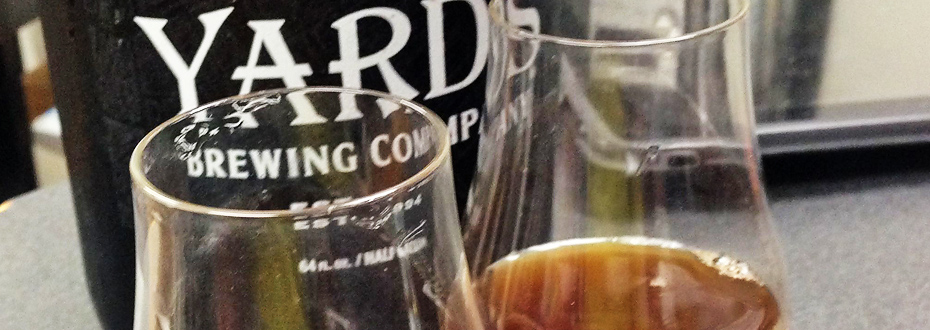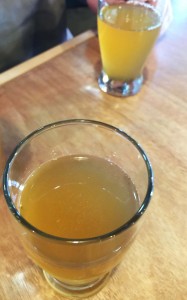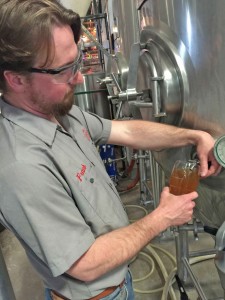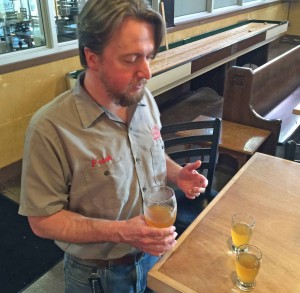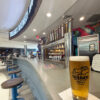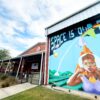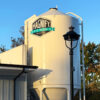
Tom, it’s not that sour! But Tom has to admire his new sour blend, Yards first commercial sour – for the 20th anniversary of Yards.
(This is part of an on-going series documenting the development of Yards Brewing Company’s Sour Beer portfolio. Called the “Spontaneous Generation Project” I periodically post updates as events occur.)
This project has really taken off at Philly’s own Yards Brewery, with several of their brewers and others pitching in with their ideas, time and effort over the past year or so to make it happen. We started the project with three barrels in the winter of 2013 with some hope and some ideas. Now as we have added more barrels and the original brews aged and were tasted, interest within the brewery grew. Finally, this April, Tom Kehoe – founder and owner decreed that the Yards 20th Anniversary Beer would be a sour.
All of a sudden a new product had to be put together and made ready for the public by May 21 – celebrating the 20th year of Yards Brewing. It would be a small batch -as just 30 sixtels would be created, but it had to be good, and worthy of being the anniversary beer.
First, a special base beer was created from predominately pilsner malt with minimal hop addition. This beer was then “kettle soured”. This is a process in which after the mash is rinsed, the wort is cooled in the brew kettle, and lactobacillus – a wild yeast is directly added to the kettle – then the beer is left alone to ferment for a couple of days. After the short fermenting period, the PH is tested to see if the souring is sufficient. Once the desired PH level is reached (about 3.5 or less), the wort is reheated, boiled and finished like a usual brew.
Now here’s where the fun starts – as the various soured beers that we have been working with for over two years (some more than three years old) will be blended against the kettle soured base beer to create a new sour beer with optimum body, taste and aroma.
The process of blending the beers is creative and subjective, driven by individual palates and tastes. Franklin Winslow, Yards QC brewer and shepherd of the project, described how Tom and his brewers sat at a table, with the various sours in growlers, pouring them together and talking though the flavor profiles. (He also told me that “beer created by committee” was not the best way to do it necessarily – but such was the situation – and everyone ended up liking the result this time).
One of the main additions would be the Yards Saison that we dosed with Brettanomyces wild yeast in a Merlot barrel in May 2014. When we sampled it a few months ago it had very nice but and subtle flavor on it’s own, and was very drinkable already.
The other addition would be the soured Brawler – which had aged in the same barrel as the original kettle soured Thomas Jefferson Ale – which had been the inspiration of the project (it had sat in that barrel for almost three years!) The Brawler had been racked into the barrel around March of 2013 – when we actively started this project, and had developed that distinct earthy tang that you wanted from a wild ale. It tasted almost like it had been dosed with cherries, with a lively almost salty taste.
The final recipe ended being roughly 5 parts base beer, 1.5 parts Brett Saison and 1 part soured Brawler.
And a fine tasting blend it is. Not overly sour, but clearly a wild ale – with the flavors blended together to create a citrusy, almost pineapple flavored dry and light bodied tart ale. There were a few notes of vanilla and cherry in the background that helped round out the flavor. I had it about 1/3 carbonated, and I am certain that when it’s fully carbonated it will be even better – with a bit more body and just a little more snap. I can’t wait to try it when it’s fully ready – as it already tasted wonderful. Those lucky folks at the Yards tap room the night we tasted it together all agreed – including some people who said they “didn’t like sour beers”.
How can you get a taste? Well, any Beer Appreciator can try it! It debuts at the Dawson Street Pub in “upper” Manayunk on May 21st at 7pm. Get there early cause it will be quite a draw. Where will the other sixtels end up? I don’t know, but I will be looking for them – cause if I have learned anything from this project – it really can be better to be sour than bitter!


